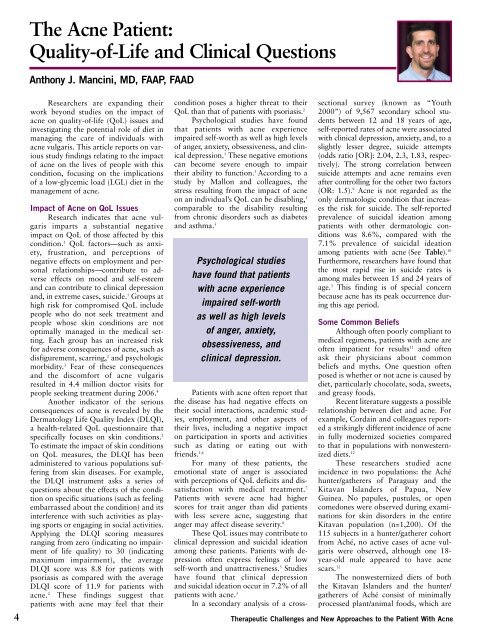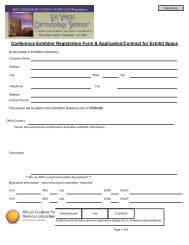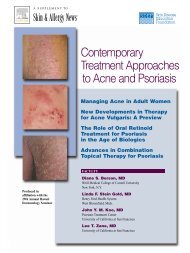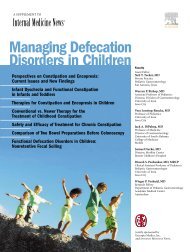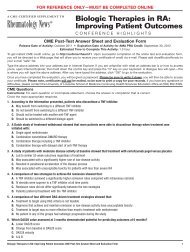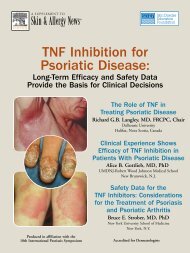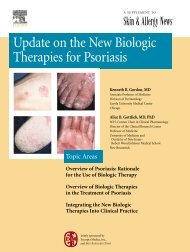Skin & Allergy News® - Global Academy for Medical Education
Skin & Allergy News® - Global Academy for Medical Education
Skin & Allergy News® - Global Academy for Medical Education
You also want an ePaper? Increase the reach of your titles
YUMPU automatically turns print PDFs into web optimized ePapers that Google loves.
The Acne Patient:<br />
Quality-of-Life and Clinical Questions<br />
Anthony J. Mancini, MD, FAAP, FAAD<br />
Researchers are expanding their<br />
work beyond studies on the impact of<br />
acne on quality-of-life (QoL) issues and<br />
investigating the potential role of diet in<br />
managing the care of individuals with<br />
acne vulgaris. This article reports on various<br />
study findings relating to the impact<br />
of acne on the lives of people with this<br />
condition, focusing on the implications<br />
of a low-glycemic load (LGL) diet in the<br />
management of acne.<br />
Impact of Acne on QoL Issues<br />
Research indicates that acne vulgaris<br />
imparts a substantial negative<br />
impact on QoL of those affected by this<br />
condition. 1 QoL factors—such as anxiety,<br />
frustration, and perceptions of<br />
negative effects on employment and personal<br />
relationships—contribute to adverse<br />
effects on mood and self-esteem<br />
and can contribute to clinical depression<br />
and, in extreme cases, suicide. 1 Groups at<br />
high risk <strong>for</strong> compromised QoL include<br />
people who do not seek treatment and<br />
people whose skin conditions are not<br />
optimally managed in the medical setting.<br />
Each group has an increased risk<br />
<strong>for</strong> adverse consequences of acne, such as<br />
disfigurement, scarring, 2 and psychologic<br />
morbidity. 3 Fear of these consequences<br />
and the discom<strong>for</strong>t of acne vulgaris<br />
resulted in 4.4 million doctor visits <strong>for</strong><br />
people seeking treatment during 2006. 4<br />
Another indicator of the serious<br />
consequences of acne is revealed by the<br />
Dermatology Life Quality Index (DLQI),<br />
a health-related QoL questionnaire that<br />
specifically focuses on skin conditions. 2<br />
To estimate the impact of skin conditions<br />
on QoL measures, the DLQI has been<br />
administered to various populations suffering<br />
from skin diseases. For example,<br />
the DLQI instrument asks a series of<br />
questions about the effects of the condition<br />
on specific situations (such as feeling<br />
embarrassed about the condition) and its<br />
interference with such activities as playing<br />
sports or engaging in social activities.<br />
Applying the DLQI scoring measures<br />
ranging from zero (indicating no impairment<br />
of life quality) to 30 (indicating<br />
maximum impairment), the average<br />
DLQI score was 8.8 <strong>for</strong> patients with<br />
psoriasis as compared with the average<br />
DLQI score of 11.9 <strong>for</strong> patients with<br />
acne. 2 These findings suggest that<br />
patients with acne may feel that their<br />
condition poses a higher threat to their<br />
QoL than that of patients with psoriasis. 2<br />
Psychological studies have found<br />
that patients with acne experience<br />
impaired self-worth as well as high levels<br />
of anger, anxiety, obsessiveness, and clinical<br />
depression. 1 These negative emotions<br />
can become severe enough to impair<br />
their ability to function. 1 According to a<br />
study by Mallon and colleagues, the<br />
stress resulting from the impact of acne<br />
on an individual’s QoL can be disabling, 5<br />
comparable to the disability resulting<br />
from chronic disorders such as diabetes<br />
and asthma. 3<br />
Psychological studies<br />
have found that patients<br />
with acne experience<br />
impaired self-worth<br />
as well as high levels<br />
of anger, anxiety,<br />
obsessiveness, and<br />
clinical depression.<br />
Patients with acne often report that<br />
the disease has had negative effects on<br />
their social interactions, academic studies,<br />
employment, and other aspects of<br />
their lives, including a negative impact<br />
on participation in sports and activities<br />
such as dating or eating out with<br />
friends. 1,6<br />
For many of these patients, the<br />
emotional state of anger is associated<br />
with perceptions of QoL deficits and dissatisfaction<br />
with medical treatment. 7<br />
Patients with severe acne had higher<br />
scores <strong>for</strong> trait anger than did patients<br />
with less severe acne, suggesting that<br />
anger may affect disease severity. 8<br />
These QoL issues may contribute to<br />
clinical depression and suicidal ideation<br />
among these patients. Patients with depression<br />
often express feelings of low<br />
self-worth and unattractiveness. 3 Studies<br />
have found that clinical depression<br />
and suicidal ideation occur in 7.2% of all<br />
patients with acne. 3<br />
In a secondary analysis of a crosssectional<br />
survey (known as “Youth<br />
2000”) of 9,567 secondary school students<br />
between 12 and 18 years of age,<br />
self-reported rates of acne were associated<br />
with clinical depression, anxiety, and, to a<br />
slightly lesser degree, suicide attempts<br />
(odds ratio [OR]: 2.04, 2.3, 1.83, respectively).<br />
The strong correlation between<br />
suicide attempts and acne remains even<br />
after controlling <strong>for</strong> the other two factors<br />
(OR: 1.5). 9 Acne is not regarded as the<br />
only dermatologic condition that increases<br />
the risk <strong>for</strong> suicide. The self-reported<br />
prevalence of suicidal ideation among<br />
patients with other dermatologic conditions<br />
was 8.6%, compared with the<br />
7.1% prevalence of suicidal ideation<br />
among patients with acne (See Table). 10<br />
Furthermore, researchers have found that<br />
the most rapid rise in suicide rates is<br />
among males between 15 and 24 years of<br />
age. 3 This finding is of special concern<br />
because acne has its peak occurrence during<br />
this age period.<br />
Some Common Beliefs<br />
Although often poorly compliant to<br />
medical regimens, patients with acne are<br />
often impatient <strong>for</strong> results 11 and often<br />
ask their physicians about common<br />
beliefs and myths. One question often<br />
posed is whether or not acne is caused by<br />
diet, particularly chocolate, soda, sweets,<br />
and greasy foods.<br />
Recent literature suggests a possible<br />
relationship between diet and acne. For<br />
example, Cordain and colleagues reported<br />
a strikingly different incidence of acne<br />
in fully modernized societies compared<br />
to that in populations with nonwesternized<br />
diets. 12<br />
These researchers studied acne<br />
incidence in two populations: the Aché<br />
hunter/gatherers of Paraguay and the<br />
Kitavan Islanders of Papua, New<br />
Guinea. No papules, pustules, or open<br />
comedones were observed during examinations<br />
<strong>for</strong> skin disorders in the entire<br />
Kitavan population (n=1,200). Of the<br />
115 subjects in a hunter/gatherer cohort<br />
from Aché, no active cases of acne vulgaris<br />
were observed, although one 18-<br />
year-old male appeared to have acne<br />
scars. 12 The nonwesternized diets of both<br />
the Kitavan Islanders and the hunter/<br />
gatherers of Aché consist of minimally<br />
processed plant/animal foods, which are<br />
4 Therapeutic Challenges and New Approaches to the Patient With Acne


